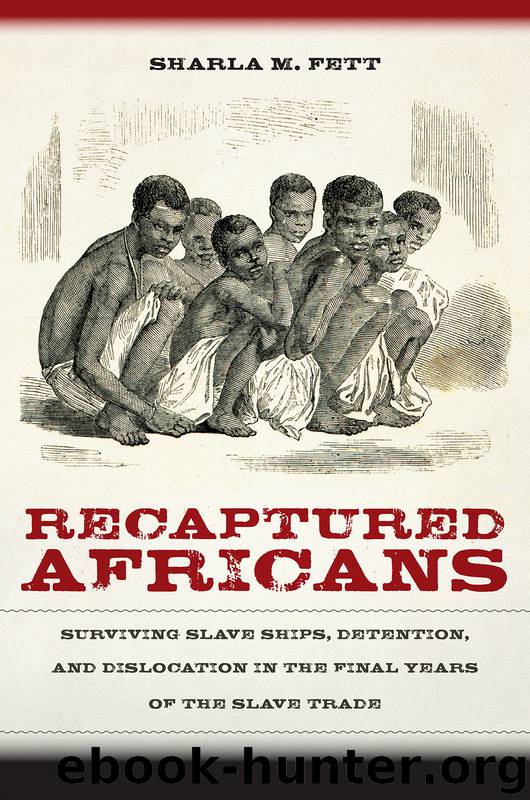Recaptured Africans by Fett Sharla M.;

Author:Fett, Sharla M.;
Language: eng
Format: epub
Publisher: University of North Carolina Press
Published: 2017-12-27T05:00:00+00:00
MARRIED.—On Thursday, the 17th inst. (March,) at the Colonization Receptacle in Monrovia, by the Rev. John Seys, KABENDAH, alias JAMES BUCHANAN, to KANDAH, alias ANN LIBERIA JEFFS, both liberated Africans of the company by the US Ship Niagara.
∼African Repository quoting Liberia Christian Advocate, 1859
Four months after their arrival in Monrovia, Kandah and Kabendah, former recaptives of the Echo, were married by the U.S. agent for recaptured Africans John Seys. Everything about the ceremony revealed the tenuous nature of the couple’s new lives in Liberia. The wedding took place among fellow shipmates in the designated quarters (“Receptacle”) for newly arrived recaptives. According to a Liberian newspaper, Methodist clergyman Seys officiated, “in as nearly a civilized and christian style as their own rude and barbarous state would admit of.”1 Considering the transatlantic ordeal Kandah and Kabendah had survived together, their union powerfully illustrates how new social bonds could be built upon existing ties between shipmates. Indeed, as we shall see, just two weeks before this marriage ceremony, Echo recaptives had forcefully exerted themselves on behalf of a fellow shipmate—a fact that went unmentioned in the African Repository announcement. At the same time, however, the language of the announcement conveys how Liberian colonial interests shaped the pathways by which West Central African recaptives slowly became Liberian “Congoes.” Having passed through stormy U.S. debates over slavery and race, slave trade refugees like Kandah and Kabendah would now be claimed by a Liberian civilizing mission premised upon the wary incorporation of recaptives into African American emigrant households. Owing to the influx of an unprecedented wave of West Central African recaptives in the years immediately following their arrival, Kandah and Kabendah would become known not only by newly assigned English names but also by the broad ethnonym “Congoes.”2
Kandah and Kabendah’s story reveals in microcosm how recaptives removed to Liberia by U.S. mandate continued to confront death, dislocation, and dependency. African passengers had disembarked from the Niagara’s long voyage only to experience the death of ten more of their shipmates from illness and exhaustion. During the early months of 1859, American Colonization Society (ACS) and Liberian officials divided surviving shipmates into smaller contingents and distributed them throughout the settler population. A group of ailing recaptives remained behind in the Monrovian receptacles, but Liberian authorities and the U.S. agent sent approximately thirty people each to the smaller settlements of Robertsport in Grand Cape Mount, Grand Bassa, Sinoe, and Cape Palmas (see fig. 6.1).3 Protestant missions took in some of the children, while others remained in temporary housing until they could be apprenticed to Liberian families.4 As the ship’s company fragmented, Kandah remained behind in Monrovia, while Kabendah, according to the Liberian Christian Advocate, sailed unwillingly south to Grand Bassa, where he grieved for Kandah until authorities decided the two should be reunited. Although details of the pair’s relationship are sparse, we should look beyond the obvious sentimentalization of the Christian Advocate story to grasp the couple’s resolve not to be separated by administrative decision. Recaptive children, men, and women sought to build on and protect the social bonds they had forged throughout their voyages.
Download
This site does not store any files on its server. We only index and link to content provided by other sites. Please contact the content providers to delete copyright contents if any and email us, we'll remove relevant links or contents immediately.
| Africa | Americas |
| Arctic & Antarctica | Asia |
| Australia & Oceania | Europe |
| Middle East | Russia |
| United States | World |
| Ancient Civilizations | Military |
| Historical Study & Educational Resources |
Goodbye Paradise(2974)
Men at Arms by Terry Pratchett(2408)
Tobruk by Peter Fitzsimons(2065)
Pirate Alley by Terry McKnight(1911)
Arabs by Eugene Rogan(1840)
Borders by unknow(1791)
Belonging by Unknown(1473)
The Biafra Story by Frederick Forsyth(1327)
It's Our Turn to Eat by Michela Wrong(1305)
Botswana--Culture Smart! by Michael Main(1239)
A Winter in Arabia by Freya Stark(1226)
Gandhi by Ramachandra Guha(1197)
Coffee: From Bean to Barista by Robert W. Thurston(1184)
Livingstone by Tim Jeal(1153)
The Falls by Unknown(1143)
The Source by James A. Michener(1137)
The Shield and The Sword by Ernle Bradford(1102)
Egyptian Mythology A Fascinating Guide to Understanding the Gods, Goddesses, Monsters, and Mortals (Greek Mythology - Norse Mythology - Egyptian Mythology) by Matt Clayton(1089)
Africa: Altered States, Ordinary Miracles by Richard Dowden(1080)
